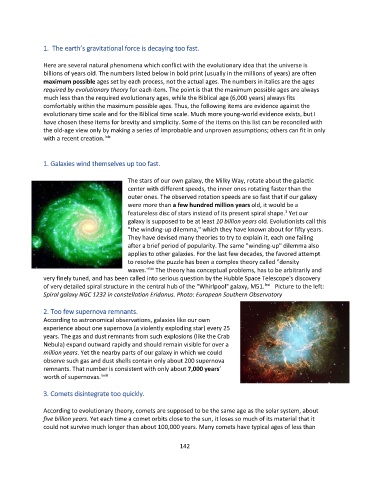Page 144 - Doctrine and History of the Preservation of the Bible revised
P. 144
1. The earth’s gravitational force is decaying too fast.
Here are several natural phenomena which conflict with the evolutionary idea that the universe is
billions of years old. The numbers listed below in bold print (usually in the millions of years) are often
maximum possible ages set by each process, not the actual ages. The numbers in italics are the ages
required by evolutionary theory for each item. The point is that the maximum possible ages are always
much less than the required evolutionary ages, while the Biblical age (6,000 years) always fits
comfortably within the maximum possible ages. Thus, the following items are evidence against the
evolutionary time scale and for the Biblical time scale. Much more young-world evidence exists, but I
have chosen these items for brevity and simplicity. Some of the items on this list can be reconciled with
the old-age view only by making a series of improbable and unproven assumptions; others can fit in only
lxix
with a recent creation.
1. Galaxies wind themselves up too fast.
The stars of our own galaxy, the Milky Way, rotate about the galactic
center with different speeds, the inner ones rotating faster than the
outer ones. The observed rotation speeds are so fast that if our galaxy
were more than a few hundred million years old, it would be a
featureless disc of stars instead of its present spiral shape. Yet our
1
galaxy is supposed to be at least 10 billion years old. Evolutionists call this
"the winding-up dilemma," which they have known about for fifty years.
They have devised many theories to try to explain it, each one failing
after a brief period of popularity. The same "winding-up" dilemma also
applies to other galaxies. For the last few decades, the favored attempt
to resolve the puzzle has been a complex theory called "density
waves." The theory has conceptual problems, has to be arbitrarily and
lxx
very finely tuned, and has been called into serious question by the Hubble Space Telescope's discovery
of very detailed spiral structure in the central hub of the "Whirlpool" galaxy, M51. Picture to the left:
lxxi
Spiral galaxy NGC 1232 in constellation Eridanus. Photo: European Southern Observatory
2. Too few supernova remnants.
According to astronomical observations, galaxies like our own
experience about one supernova (a violently exploding star) every 25
years. The gas and dust remnants from such explosions (like the Crab
Nebula) expand outward rapidly and should remain visible for over a
million years. Yet the nearby parts of our galaxy in which we could
observe such gas and dust shells contain only about 200 supernova
remnants. That number is consistent with only about 7,000 years’
worth of supernovas. lxxii
3. Comets disintegrate too quickly.
According to evolutionary theory, comets are supposed to be the same age as the solar system, about
five billion years. Yet each time a comet orbits close to the sun, it loses so much of its material that it
could not survive much longer than about 100,000 years. Many comets have typical ages of less than
142

